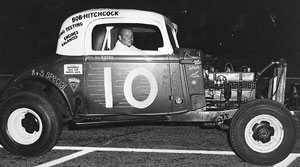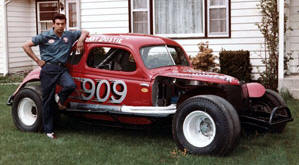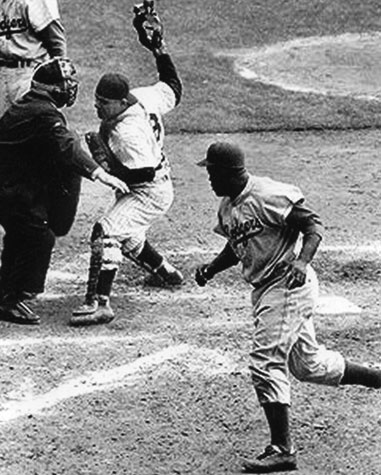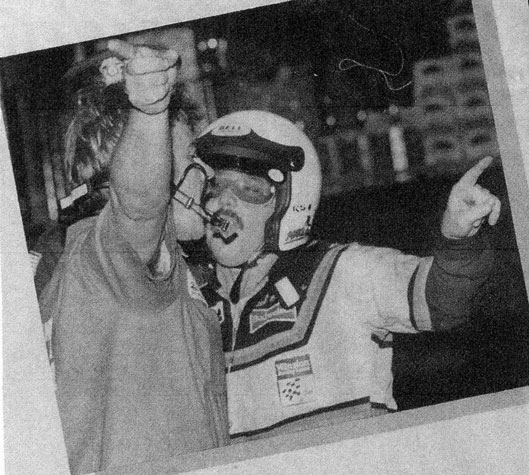|
7/7/14
GEORGE AND ART’S SWEET SORROW
What an unlikely duo. Art Barry –
lean, lanky and serious, and George Summers – big-
muscled and
bubbly. But what a beautiful friendship they have had.
Back
in 1952, Art Barry first chugged over from Preston City,
Connecticut, to New London with a stock car. It was rudimentary
stuff. “I couldn’t afford to drive it myself, so I had to hire
someone else,” he recalls. It would be hard to remember the
specifics, as he’s been doing the same thing every summer weekend
for the last 62 years.
Art never would become a driver
himself, but by the late 1970s, his ride was highly sought after in
NASCAR Modified racing. That’s when he was looking for a new shoe,
and Dick Armstrong introduced him to George Summers.
George
also got started in 1952, in this case up at Westboro Speedway, but
in an equally modest way. George pitted “an old Chevy ramp racer
with a knee-action front end that didn’t stop bouncing until it hit
another ramp.” He progressed through Non-Ford wars, finding
particular success in a Jimmy-powered #10 square-top coupe built by
Dick Jackson and owned by engine-builder Bo Noyes.
George
became a superlatively competent short-tracker with a distinctive
style on the
bullrings. He had a groove all his own at Westboro,
has been the all-time feature winner at Seekonk, and shone brightly
in Late Model open competitions at Maine ‘s Oxford Plains Speedway.
  |
“George came of age and put a
real drubbing on the Non-Ford guys with this little
coupe. There was no question he was headed for the
big time. On the right is Art Barry with one his
many, many showpiece Modifieds, this one from the
late 1960s, his #909 era. It was called the Stump
Jumper and it was driven by Jerry Dostie.
(Left:
Dave Dykes Collection)
(Right: Rene Degas Photo,
Dave Dykes Collection)
|
|
George
enthuses, “Something clicked with Art and me immediately. What a
great relationship! We won at Seekonk the second night out. You
know, I looked at myself as just a Saturday- night racer, but Art
really gave me confidence. We started going to Thompson and places
like Martinsville, and we did so well. Especially when we pooled
resources with some Jack Tant motors.”
Thoughtful Art
concurs. “That man just drove his heart out for me. I learned to
have so much trust in him that I just said ‘do whatever you want out
there, George. Just don’t wreck my car running at the back.’ He sure
never did that.”
The two did each other proud and won a ton
of races, but everything has its season. At the Thompson 300 in
1983, George was running right up front, but, to everyone’s surprise
– including his own, he dropped out. Once in the pits, the problem
was obvious. At 49, he was just plain tuckered out.
George’s
situation was not unusual. He and other Modified pioneers had
endured three hard-paced and often injury-laden decades of racing.
They were getting older, feeling the ghosts of flips past, and the
sleeplessness of endless miles to and from the races. On top of
that, the newer Modifieds were lightning fast at places like
Thompson. The centrifugal forces over 1200 corners in a 300-lapper
could wear out the mightiest of biceps.
It must not have been
easy for George, a racer through and through, to tell Art that he
would retire at the end of the season. And as fate would have it,
the decision became even more difficult.
The second-to-last
race of the ’83 season was a Modified show at the Oxford one-third
mile. Art’s car was on rails that day, even on hard rubber. Those
tires did their job, and in a late race restart, George blasted by
an increasingly loose George Kent for a huge – and hugely popular –
win.
On the way back down the Maine Turnpike, George and his
wife Maggie had quite a
conversation. George was beside himself,
convinced he could never pull off anything like that again, and
wondering if it wouldn’t be best to quit right now, at the top of
his game. But, alas, he had promised Art he would run until the end
of the season, and there was still Thompson. Art was his friend. He
had to go.
In qualifying Saturday at Thompson, everything
seemed calm and ordinary. But the next day was a different story.
From the moment the pits opened, the place was abuzz with cameras,
well-wishers, and tears about George’s final race. Emotions ran
high. Art recalls, “At one point I just had to take George around
the pits by the arm and talk to him, tell him to forget all the
noise, and try to remember that we were there to race.”
Race
they did, and, unbelievably, once again it would be George’s day.
The grandstands thundered with approval when he won, and it appeared
there was not a single grownup in the pits. George was thoroughly
sprayed with champagne before even getting out of the car. “And,
when I did climb out, I just cried. It was so beautiful. What a way
to go out. To win the last one was storybook; taking two was
unthinkable.”
Needless to say, the celebration soon oozed its
way up the hill to the Clubhouse, where it carried on until the wee
hours. At one point Richie Evans, rarely beaten in that era, walked
up to Art and said, “What in the world did you guys do to that car
today? You had to be cheating, because I sure was.”
So the
chapter ended, but not the story. Amazingly, Art just kept right on
going. Fact is, on that day in 1983, he wasn’t even half way through
his racing career, and it has only gone meteoric since then. By the
time he was inducted into the New England Auto Racers Hall of Fame a
couple of years back, he had won at 26 different tracks, taking down
two NASCAR Tour Championships, two Thompson 300s, two Stafford
Spring Sizzlers and two national events at Martinsville. The totally
topped and tailed SPAFCO Modifieds he continues to build for
customers remain among the most desired equipment in competition
today.
And his buddy George is never far from the scene,
either, actively involved with racing
charities, the North East
Motor Sports Museum, and the NEAR Hall of Fame.
There is no
question that there are some competitive genes in that Summers
family. George’s dad was Bill Summers, the baseball umpire. Bill is
shown below, getting a piece of Yankee catcher Yogi Berra’s mind
after Summers called Dodger Jackie Robinson safe stealing home.
 |
| (Summers Family Collection) |
|
On the right is George and Maggie’s son Ricky, who was a journeyman
Modified driver himself. He is showing some of that old Summers
enthusiasm in an active discussion with Paul Cokely, at the time the
starter at Riverside Park.
 |
|
(Summers Family Collection) |
|
© 2014 Lew Boyd
- Coastal 181
|
If
you were interested in this Tearoff, you might enjoy
the book below: |
|
|